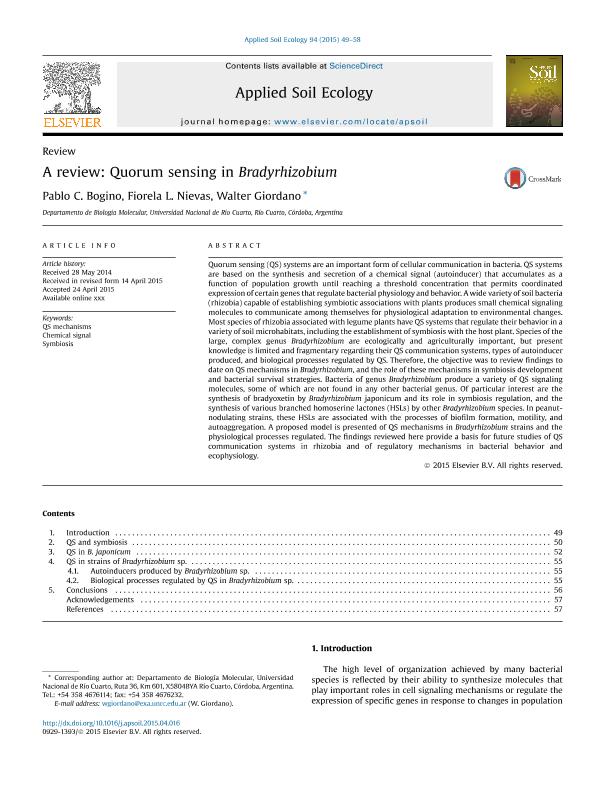Artículo
A review: Quorum sensing in Bradyrhizobium
Fecha de publicación:
05/2015
Editorial:
Elsevier Science
Revista:
Applied Soil Ecology
ISSN:
0929-1393
Idioma:
Inglés
Tipo de recurso:
Artículo publicado
Clasificación temática:
Resumen
Quorum sensing (QS) systems are an important form of cellular communication in bacteria. QS systems are based on the synthesis and secretion of a chemical signal (autoinducer) that accumulates as a function of population growth until reaching a threshold concentration that permits coordinated expression of certain genes that regulate bacterial physiology and behavior. A wide variety of soil bacteria (rhizobia) capable of establishing symbiotic associations with plants produces small chemical signaling molecules to communicate among themselves for physiological adaptation to environmental changes. Most species of rhizobia associated with legume plants have QS systems that regulate their behavior in a variety of soil microhabitats, including the establishment of symbiosis with the host plant. Species of the large, complex genus Bradyrhizobium are ecologically and agriculturally important, but present knowledge is limited and fragmentary regarding their QS communication systems, types of autoinducer produced, and biological processes regulated by QS. Therefore, the objective was to review findings to date on QS mechanisms in Bradyrhizobium, and the role of these mechanisms in symbiosis development and bacterial survival strategies. Bacteria of genus Bradyrhizobium produce a variety of QS signaling molecules, some of which are not found in any other bacterial genus. Of particular interest are the synthesis of bradyoxetin by Bradyrhizobium japonicum and its role in symbiosis regulation, and the synthesis of various branched homoserine lactones (HSLs) by other Bradyrhizobium species. In peanut-nodulating strains, these HSLs are associated with the processes of biofilm formation, motility, and autoaggregation. A proposed model is presented of QS mechanisms in Bradyrhizobium strains and the physiological processes regulated. The findings reviewed here provide a basis for future studies of QS communication systems in rhizobia and of regulatory mechanisms in bacterial behavior and ecophysiology.
Palabras clave:
Chemical Signal
,
Qs Mechanisms
,
Symbiosis
Archivos asociados
Licencia
Identificadores
Colecciones
Articulos(CCT - CORDOBA)
Articulos de CTRO.CIENTIFICO TECNOL.CONICET - CORDOBA
Articulos de CTRO.CIENTIFICO TECNOL.CONICET - CORDOBA
Citación
Bogino, Pablo Cesar; Nievas, Fiorela Lujan; Giordano, Walter Fabian; A review: Quorum sensing in Bradyrhizobium; Elsevier Science; Applied Soil Ecology; 94; 5-2015; 49-58
Compartir
Altmétricas




